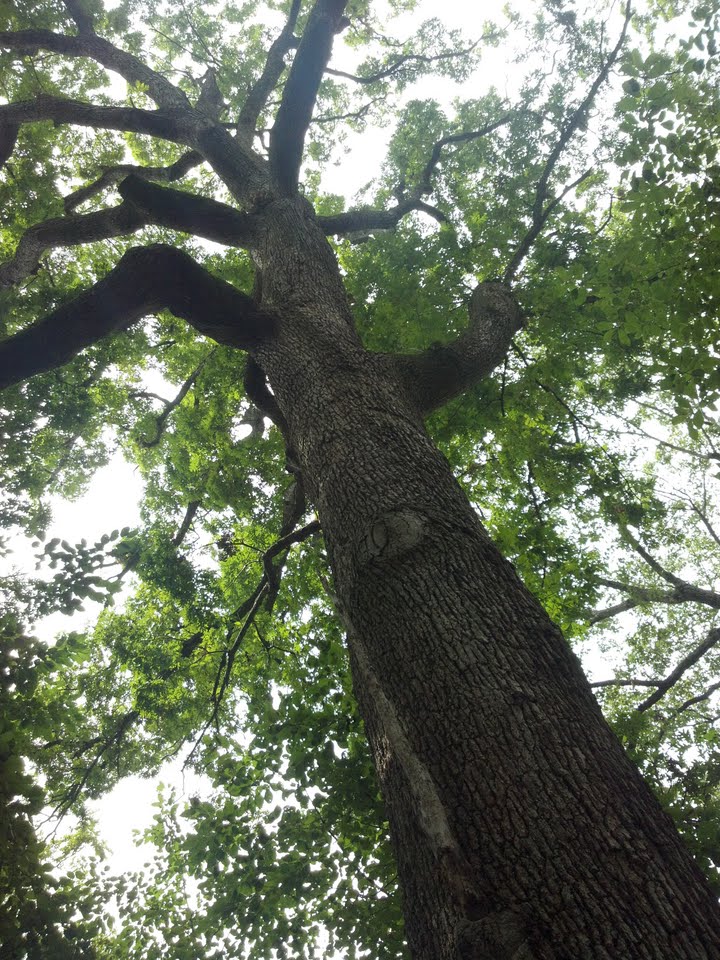As a reminder to the thousands that stand behind Stadium Woods – they are not saved. Until we hear an announcement of their fate – we are at serious risk of losing something irreplaceable. We think it is important for the public and the administration to know that we care. We care as students, professors, and community members about the fate of the woods. That’s why we were out there. That’s why we write these words today.
By the VT Environmental Coalition
 A lack of sensible decision making by Virginia Tech officials led to the felling of a 300 to 400 year old white oak that stood 85 feet tall and 4 feet in trunk diameter. This decision led to public unrest on August 9, 2012, the day the tree was cut. There is little trust left between the University administration and faculty, students, town and world citizens.
A lack of sensible decision making by Virginia Tech officials led to the felling of a 300 to 400 year old white oak that stood 85 feet tall and 4 feet in trunk diameter. This decision led to public unrest on August 9, 2012, the day the tree was cut. There is little trust left between the University administration and faculty, students, town and world citizens.
The Virginia Tech Arboretum Committee, composed of forestry professionals and faculty who manage the campus forestry landscape by advising University officials, has been overseeing the fate of this tree since February 2012. After the university received results of two reports from certified arborists that the tree was a potential safety risk, they further recommended to Virginia Tech officials and facilities that the area should be roped off to protect students and pedestrians in February and again earlier last week. Committee chair and Virginia Tech urban forestry professor Eric Wiseman wrote by email that area should be roped off “until a decision about the fate of Stadium Woods is made because that judgment might influence the risk and liability associated with the tree.” Other members of the Arboretum committee urged that a decision should wait until a management plan was written for Stadium Woods. “Should the woods be preserved by the University, work will begin immediately on a management plan and certainly that plan would not recommend felling any trees in a functioning uneven-aged old growth forests,” noted Alumni Distinguished Forestry Professor John Seiler.
As plans to remove the tree moved forward early last week, emeritus professor and forester Jeff Kirwan urgently requested a delay of university plans in an email to Virginia Tech administrators Tuesday. Dr. Kirwan called for a reevaluation of the arborists reports based on several assumptions, most importantly that the tree was in a high use area and other flaws found in the original risk analysis. He explained that the tree was located over 100 feet from the nearest walking path and further steps could be made to moderate risk without killing the tree. “This tree is likely to be much older than the United States Constitution, Monticello, Mount Vernon, and is extremely rare. If we can wait from February until now to take action, certainly we can give it a few more days (or weeks) for thoughtful discussion and reevaluation,” he further explained.
John Seiler noted the tree was sound enough to survive the high winds of this summer’s derecho (high wind event) and the devastating ice storms of 1994, and has likely lived with the present stem condition for 50 to 100 years.
On the afternoon of Tuesday, August 7, facilities staff roped off the area, leading the Arboretum Committee and others to believe they would wait for further analysis on the ultimate fate of the condemned tree and Stadium Woods. Nevertheless, despite the clear opposition and plea for discussion, VT facilities and administrators did not respond to the request of arboretum committee members or others concerns. On Thursday, without notice, the heritage tree was cut down amid a heavy police presence.
The Arboretum Committee was not informed of the decision. It seems that the Virginia Tech motto “We are Virginia Tech” may be a dying philosophy. “It appeared that the officials were heeding the advice of all parties and the Arboretum Committee by placing the perimeter of the tree off limits Tuesday,” explained Environmental Coalition Vice President Abby Hays that night, “however, we were all irrationally ignored.”
“Safety trumps everything,” said university spokesperson Mark Owczarski according to a Roanoke Times article August 10. Owczarski explained the tree was a “threat to our community.” However, the university allowed the tree to remain standing during the entire spring semester without placing any fence or warning people, despite the first arborists evaluation in February making a specific recommendation for a fence to be put up immediately.
In response to the trees abrupt demise Thursday, the Environmental Coalition student organization and the Friends of Stadium Woods held a night vigil at the scene. Its purpose was to acknowledge the life of the ancient white oak that was believed to have lived between 300 to 400 years. Virginia Tech students, faculty, and the public are now more passionate and determined to protect the remaining old growth ancient trees.
“The decision Virginia Tech President Charles Steger makes for preserving or destroying a significant portion of Stadium Woods will reflect directly upon how Virginia Tech values learning and whether they choose to uphold the very values and concepts taught in our classes,” said Environmental Coalition President Erica Largen in the candle light. “We are here to make sure all Hokie legacies are protected and can be shared with future students. Stadium Woods with their majestic trees and countless ecological benefits must be preserved for future generations.”



